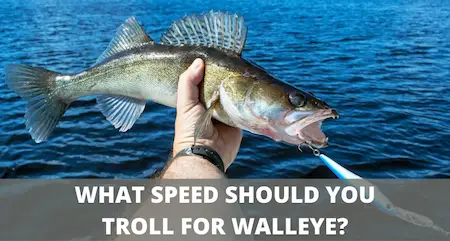What Speed Should You Troll For Walleye? (3 Things You Need To Know)
UPDATED 03 NOVEMBER 2023
by Robert Ceran
Trolling is one of the most effective ways to catch walleye because you can cover a lot of water effortlessly all day long, and find those roving packs of hunting walleye.
But a key aspect for success with this tactic is choosing the right speed.
So what is a good trolling speed for walleye?

Here’s the quick answer:
The best walleye trolling speed depends on the season, and is generally higher in summer than in spring and fall:
- Spring: 0.5 to 1 mph
- Summer: 1.8 to 2.2 mph (and up to 3.5 mph)
- Fall: 1.3 to 1.8 mph
What is a good trolling speed for walleye?
The ideal walleye trolling speed depends on two main factors: the season (and hence water temperature), and your bait presentation.
In general terms, your trolling speed should be higher in the summer, when walleye are more active, and slower in spring and fall, when walleye are more lethargic due to colder water temperatures.
In addition, hard bait lures are ideal for higher speeds, while live bait rigs need to be trolled at lower speeds.
Now let’s look more closely at each of the seasons to get a better understanding of what works best at different times of the year.
Spring walleye trolling speed
The best trolling speed for spring walleye is from 0.5 to 1 mph. Early on in the season, when the water is still cold, it’s best to use a slow trolling speed under 1 mph, and speeds of 0.7 or 0.8 mph can work extremely well at this time of the year.
At this speed you’re barely moving the bait in the water, which is essential in spring, since walleye are more lethargic in cold water.
Especially during the spawn or post spawn period, the water can be very cold (in the upper 30s or lower 40s), and the fish only move around slowly, and won’t chase your bait over big distances.
Because of this you need to give spring walleye a chance to catch up with your bait by slowing it down to a very slow wobble, to where it’s hardly moving at all. These tactics are also great for night tolling in spring.
This is in stark contrast to summer, where faster trolling speed can trigger reaction strikes from walleye that are willing to chase your lure over longer distances.
The best lures to use in spring are stickbaits and suspended crankbaits fished in shallow water around 5 to 8 feet deep.
This is especially effective for targeting post spawn walleye that are eager to feed, in order to regenerate their strength after the spawn.
If you’re trolling in the middle of the day in spring, and the sun is out, you can increase your trolling speed up to 2 mph.
At these times it’s great to target shallow sand flats, where you can find walleye sunning themselves to increase their body temperature after the cold season.
Summer walleye trolling speed
The best trolling speed for summer walleye is from 1.8 mph to 2.2 mph (and you can go all the way up to 3.5 mph at this time of the year). In the summer it’s ideal to use a fast trolling speed for most bait presentations.
The only exception to this is if you’re trolling with live bait rigs in summer, when it’s better to slow down the speed to around 1.2 mph, as you don’t want to rip the live bait off the hook by going too fast.
If you’re trolling with crankbaits in the summer, and not getting any bites while trolling at 2mph speed, it’s often worth increasing your trolling speed to 3 mph or 3.5 mph, since the higher speed can trigger reaction bites from fish that aren’t actively feeding.
Another advantage of higher trolling speed is that you tend to catch bigger fish, while avoiding the smaller ones.
A great tactic that works well in the summer is to vary your trolling speed regularly, as the change of speed can also trigger reaction bites from walleyes that are following your lure.
An easy way to do this is by changing your course in a zigzag pattern, which will cause the lure to slow down and speed up periodically.
Fall walleye trolling speed
The best trolling speed for fall walleye is from 1.3 to 1.8 mph (and you can go up to 2.2 mph early in fall).
Water temperatures start to cool down in the fall, and it’s best to troll slower than in summer, which means you’ll hardly ever go above 2.2 mph.
In fact, during late fall, as the water temperature falls into the low 40s, you should slow down to 1.3 mph or even slower.
The best tactic at this time of the year is to troll crankbaits in open water to target walleye that are feeding on large schools of shad and other baitfish.
The key here is to use a fish finder to locate the schools of baitfish, and then target the walleye hunting them. As in summer, it can help to vary speed by changing direction regularly.
Walleye trolling speed for crawler harness
The best trolling speed for fishing with a crawler harness is from 1 to 1.4 mph. The same holds true if you’re trolling for walleye with a bottom bouncer rig.
This trolling speed is significantly slower than most other baits and setups used in the summer, and the reason for this is that you don’t want to rip off your nightcrawler from the harness by trolling at high speed.
Nightcrawlers are one of the most effective live baits for walleye in summer, and by using a crawler harness you can leverage trolling to cover a lot of ground to find those roving groups of walleye.
Just keep in mind that you need to go more slowly with this tactic than when you’re fishing with hard bait lures.
Conclusion
The best way to fine tune your walleye tolling speed is by using a trolling motor with remote control, which will allow you to vary your speed by increments of 0.1 mph.
Some of the more advanced kicker motors also have highly accurate speed control, but by far the best solution is to use a trolling motor for this.
